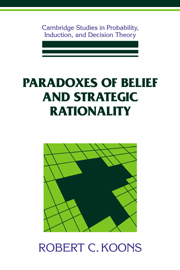Appendix B - Proofs of Theorems 2 and 3 from Chapter 6
Published online by Cambridge University Press: 06 January 2010
Summary
Theorem 2.Every fundamentally complete situation s actual in a semantically well-founded model A and such that P(s) contains no A-inexpressible propositions can be extended to a Burgean situation s* actual in A.
Proof. Let s0 be the maximal subsituation of s containing no semantic SOAS, and let P be the smallest set of propositions p such that 〈Tr, p; i〉 ∈ s or 〈Tr, p : i〉 ∈ Par(q) for some q ∈ P. Consider the unique Burgean series S based on s0 and P, S = {s0, s1, …, sa, …}. Claim: s ⊆ ∪S.
Since s is semantically well founded, there is a foundation series S′ = {s0, s1′, S2′, …} such that s ⊆ ∪ S'. It is sufficient to show that, for all a, there is a γ such that s′a ⊆ sγ. Assume for a reductio that a is the least ordinal such that, for all λ, ∼ s′a ⊆ sγ. Clearly, a > 0. By inductive hypothesis, for all δ < a, there exists an ∈ such that s′δ ⊆ s∈. Let ζ be the supremum of all such ∈, that is, for all δ < a, s′δ ⊆ sζ.
a is either a limit ordinal or a successor. If a is a limit ordinal, then it immediately follows that s′a ⊆ sζ, contradicting the hypothesis. So a is a successor, and s′a-1 ⊆ sζ. Every nonsemantic SOA in s′a–s′a-1 belongs to s0. Suppose that 〈Tr, p; i〉 ∈ s′a. We can show that 〈Tr, p; i〉 ∈ sζ+1 by induction on the complexity of p.
- Type
- Chapter
- Information
- Paradoxes of Belief and Strategic Rationality , pp. 155 - 159Publisher: Cambridge University PressPrint publication year: 1992

